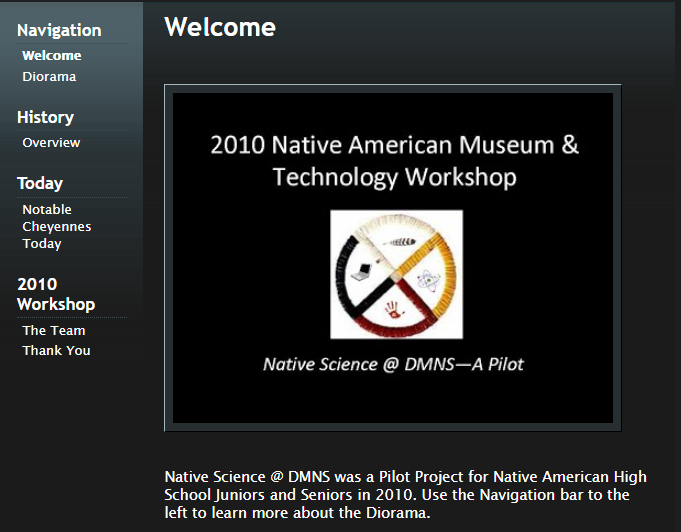Link to the article: Developing a native digital voice: Technology and Inclusivity in Museums
In 2010, at the Denver Museum of Nature and Science (DMNS), Pohawpatchoko, Colwell, Powell, and Lassos developed a two-week intensive workshop that brought 10 Native American high school students to create a working model for an interactive web interface to complement a diorama of a Cheyenne family in the early 1860s (Pohawpatchoko et al., 2017). At the end of the two weeks, the students created a working model, which they presented to their families and community members. Standing in front of their community was an act of bravery for many students and ultimately empowered them (Pohawpatchoko et al., 2017). Below is a capture of the student’s Google site (notice the students had no prior experience in web-based CS before the workshop). Even though the museum did not use the students’ digital model, still, the authors think that the experience was successful (Pohawpatchoko et al., 2017). They mentioned that the real point was that the project served Native community members: the project wasn’t about the museum; it was about the community. It provided “interns” with exposure to technical web skills, connectedness with their past towards their future goals, and a starting point for inclusivity to museum display approaches (Pohawpatchoko et al., 2017). Moreover, the workshop had positive outcomes on the educators who were learning along with their students. While reading about the educators’ experience, I thought it is connected the “Axe Handle Academy Model” expecting educators to become “the model of teaching and learning that the student studies” (Scollon & Scollon, 1986, p.92).

Screen Capture of Student’s Digital Model created in @DMNS Pilot workshop
For me, three significant aspects made the learning experience culturally responsive. Firstly, the students were involved in “a real computing experience” (Pohawpatchoko et al., 2017, p.54) relevant to their lives; the project can be regarded as “a part of museum decolonization and reformation in the twenty-first century” (Pohawpatchoko et al., 2017, p.53). Secondly, the program features the importance of community connections. It was run by, for, and with Native American community members and involved elders, artists, scholars, and other knowledgeable tribal members. It also included cultural practices, such as talking circles, allowing the students and staff to share their experiences about living their Native American identities in today’s complex world. Thirdly, the program was grounded by cultural constructionism, which provides a framework for developing customized digital tools or curricula enabling marginalized groups to participate in technology. In the study, “Indigenous culture, museum studies, and computer science [were merged] under one umbrella” (Pohawpatchoko et al., 2017, p. 54). For my project work, I regard the article as an excellent example of applying ethnocomputing. It also illustrates how the community connections are essential when applying culturally responsive approaches to broaden Indigenous youth participation in computing.
Reference:
- Pohawpatchoko, C., Colwell, C., Powell, J., & Lassos, J. (2017). Developing a native digital voice: Technology and inclusivity in museums. Museum Anthropology, 40(1), 52-64. https://doi.org/10.1111/muan.12130
- Scollon R.& Scollon, S.(1986). The Axe Handle Academy: A proposal for a bioreginal, thematic humanities education. Retrieved from https://www.uaf.edu/ankn/publications/index.php